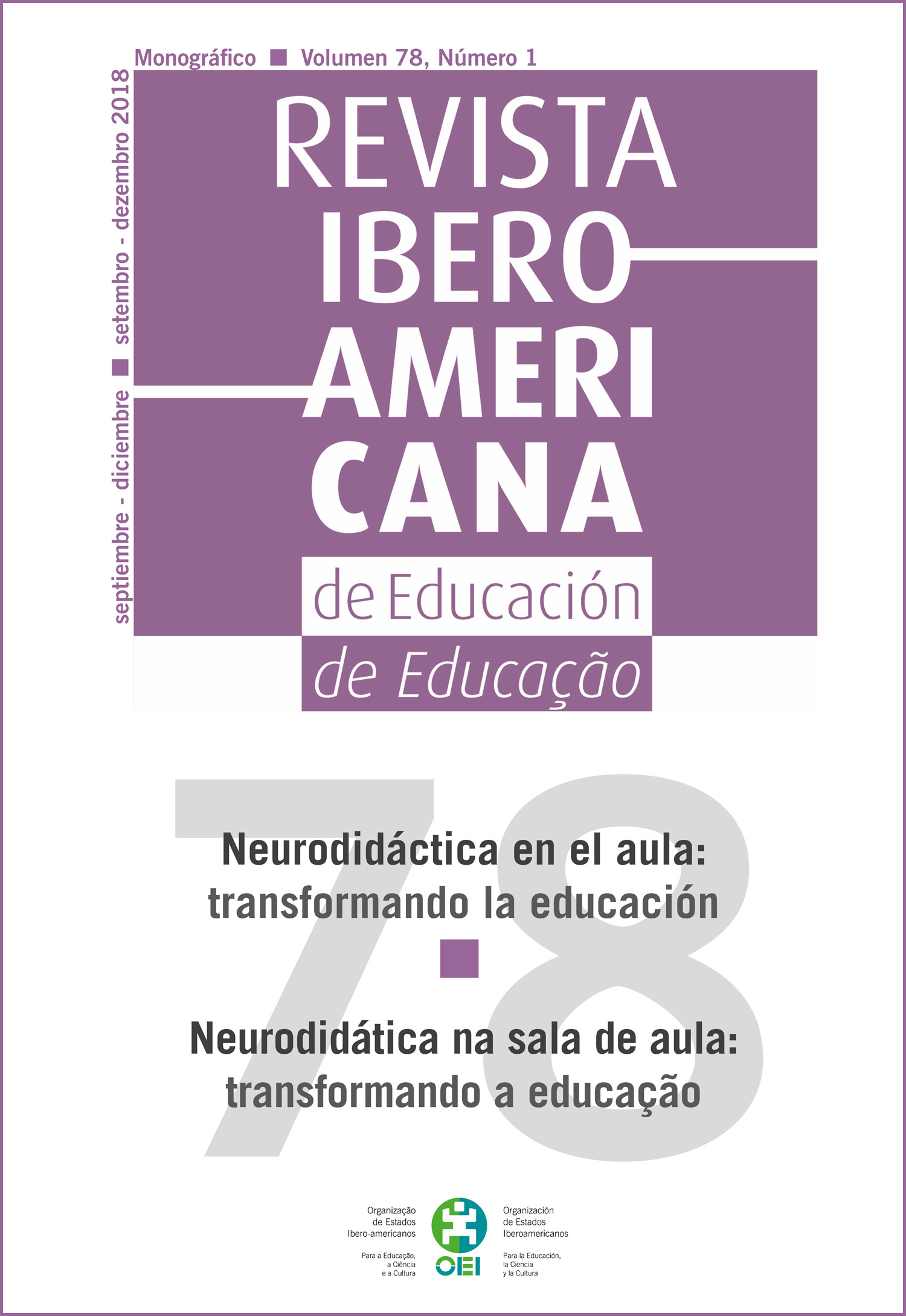Necessary dialogues: neuroscience, emotions and initial teacher training
DOI:
https://doi.org/10.35362/rie7813231Keywords:
neuroscience; emotions; pre-service teacher; supervised training courseAbstract
Studies of neuroscience have evinced the intimate connection between emotional moments and cognitive constructs in different educational contexts, evincing that the educational path is an inseparable process of emotional aspects. In this regard, it is no longer possible to think about initial teacher training without considering such interconnections, especially the supervised training course, which is an important pedagogical moment. This paper aims at investigating the emotions of Physics and Biological Sciences teachers-to-be at the Federal University of the Triângulo Mineiro (UFTM), Minas Gerais, Brazil, in their first didactic experiences in classroom. This qualitative research included class observing and audiovisual recordings of the student teacher interns, articulating them with subsequent semi-structured interviews. In the methodological field, we adopt the ideas of the Explicitation Interviews and the theoretical constructs of Paul Ekman about emotions. The results show that one of the greatest challenges faced by pre-service teacher when they begin in classrooms is to know how to deal with their emotions before different situations that arise. Some of the most frequent emotions expressed by the pre-service teacher during the classes were fear, surprise, sadness and anger. As a way of overcoming them, in many cases, they chose to move away from situations experienced as opposed to confrontation. The pre-service teacher report that mapping and discussing emotions it has been valuable in especially about yours first classes.
Downloads
References
Borrachero, A. B., Brígido, M., Mellado, L., Costillo. E. Y & Mellado, V. (2014). Emotions in prospective secondary teachers when teaching science content, distinguishing by gender. Research in Science & Technological Education, 32(2), 182-215.
Bortoli, B & Teruya, T. K. (2017). Neurociência e Educação: os percalços e possibilidades de um caminho em construção. Imagens da Educação. 7(1), 70-77.
Brasil (1996). Lei de Diretrizes e Bases da Educação Brasileira (LDB), n. 9.394, de 20 de dezembro de 1996. Ministério da Educação (MEC). Recuperado de https://www.planalto.gov.br/ccivil_03/Leis/L9394.htm
Brasil (2015). Diretrizes Curriculares Nacionais para a Formação de Professores da Educação Básica.... Resolução CNE 2/2015, de 02 de julho de 2015. Conselho Nacional de Educação. Recuperado de http://portal.mec.gov.br/index.php?option=com_docman&view=download&alias=17719-res-cne-cp-002-03072015&category_slug=julho-2015-pdf&Itemid=30192.
Carvalho, F. A. H. (2011). Neurociências e educação: uma articulação necessária na formação docente. Trab. Educ. Saúde, 8(3), 537-550.
Carvalho, D., & Boas, C. A. V. (2018). Neurociências e formação de professores: reflexos na educação e economia. Ensaio: avaliação e políticas públicas em Educação, 26 (98), 231-247.
Christodoulou, J. A.; & Gaab, N. (2009). Using and misusing neuroscience in education-related research. Cortex, 45(4), 555–557.
Costa, R. A. B., & Gonçalves, T. O. (2004). Prática de Ensino: Encontros, Desencontros e Reencontros de uma Experiência. In: Encontro Nacional De Educação Matemática. Recife, PE, 2004. Recuperado de: http:// www.sbem.com.br/files/viii/pdf/07/CC60475200144.pdf
Damásio, A. (2000). O erro de Descartes. Emoção, razão e o cérebro humano. São Paulo: Cia das Letras.
Ekman, P. (2011). A linguagem das emoções. (Carlos Szlak, Trad.). São Paulo: Lua de papel.
Gomes, A. & Colombo Junior, P. D. (2018). A produção acadêmica sobre estágio curricular supervisionado e a formação inicial de professores: uma análise a partir de revistas “Qualis A/Educação/Capes”. Revista Triângulo, 11(1), 163-180.
Grossi, M. G. R., Lopes, A. M., & Couto, P. A. (2014). A neurociência na formação de professores: um estudo da realidade brasileira. Revista da FAEEBA – Educação e Contemporaneidade, 23(41), 27-40.
Lent, R. (2010). Cem bilhões de neurônios: conceitos fundamentais da neurociência. (2. Ed) São Paulo: Atheneu.
Lederman, S., Klatzky, R., Abramowicz, A., Salsman, K., Kitada, R. & Hamilton, C. (2007). Haptic Recognition of Static and Dynamic Expressions of Emotion in the Live Face. Psychological Science, 18(2), 158-164.
Mason, L. (2009). Bridging neuroscience and education: a two-way path is possible. Cortex, 45(1), 548–549.
Mellado, V., Borrachero, A. B, Brígido, M., Melo, L.V., Dávila, M. A., Cañada, F., Conde, M. C., Costillo, E., Cubero, J., Esteban, R., Martínez, G, Ruiz, C., & Sánchez J. (2014). Las emociones en la enseñanza de las ciencias. Enseñanza de las Ciencias, 32 (3), 11-36.
Melo, L., & Cañada, F. (2018). Emociones que emergen durante el análisis del conocimiento didáctico del contenido sobre el campo eléctrico. Ciência & Educação, 24 (1), 57-70.
Murray, E. J. (1973). Motivação e Emoção. (3. Ed). Rio de Janeiro: Zahar.
Pinto, A. (2001). Psicologia geral. Lisboa: Universidade Aberta.
Santos, C. S. V. (2009). Psicofisiologia das Emoções Básicas: Estudo Empírico com Toxicodependentes em Tratamento (Dissertação de Mestrado). Universidade Fernando Pessoa, Porto, Portugal, Brasil.
Schutz, P. A, & Zembylas, M. (2009). Introduction to Advances in Teacher Emotion research: the impact in teachers’ lives. In: Schutz, P. A; Schutz, P.A.; Zembylas, M. Advances in Teacher Emotion Research: The Impact on Teachers’ Lives. New York: Springer, p. 3-73.
Shulman, L. (2015). PCK: its genesis and exodus. In: Berry, A.; Friedrichsen, P.; Loughran, J. (Ed.). Re-examining pedagogical content knowledge in science education. New York: Routledge, p. 3-13.
Strongman, K. T. (2004). A psicologia da emoção. Lisboa: Climepsi.
Vermersch, P. (2003). L’entretien d’explicitation. (4. ed). Issy-les-Molineaux, ESF: Fr.
Wykrota, J. L. M. (2007). Aspectos emocionais de procedimentos de ensino de professores de ciências do ensino médio (Tese de Doutorado). Universidade Federal de Minas Gerais, Belo Horizonte, MG, Brasil.
How to Cite
Downloads
Published
Issue
Section
License
Any authors who publish with this journal accept the following terms:















